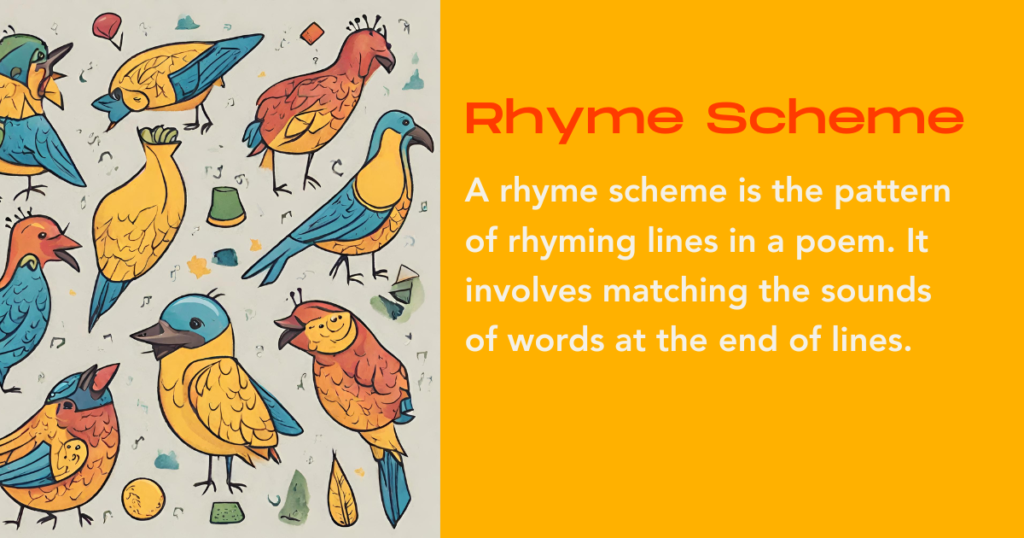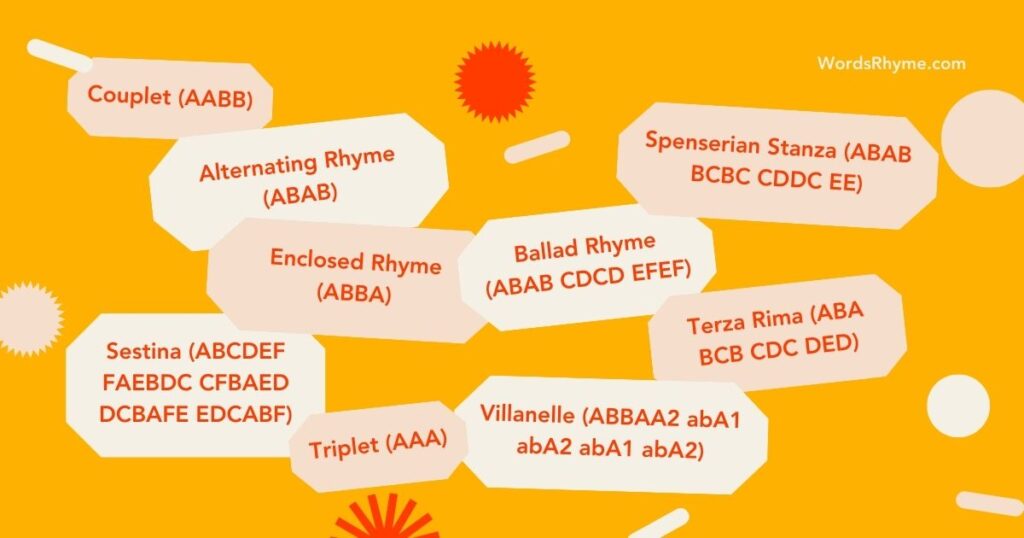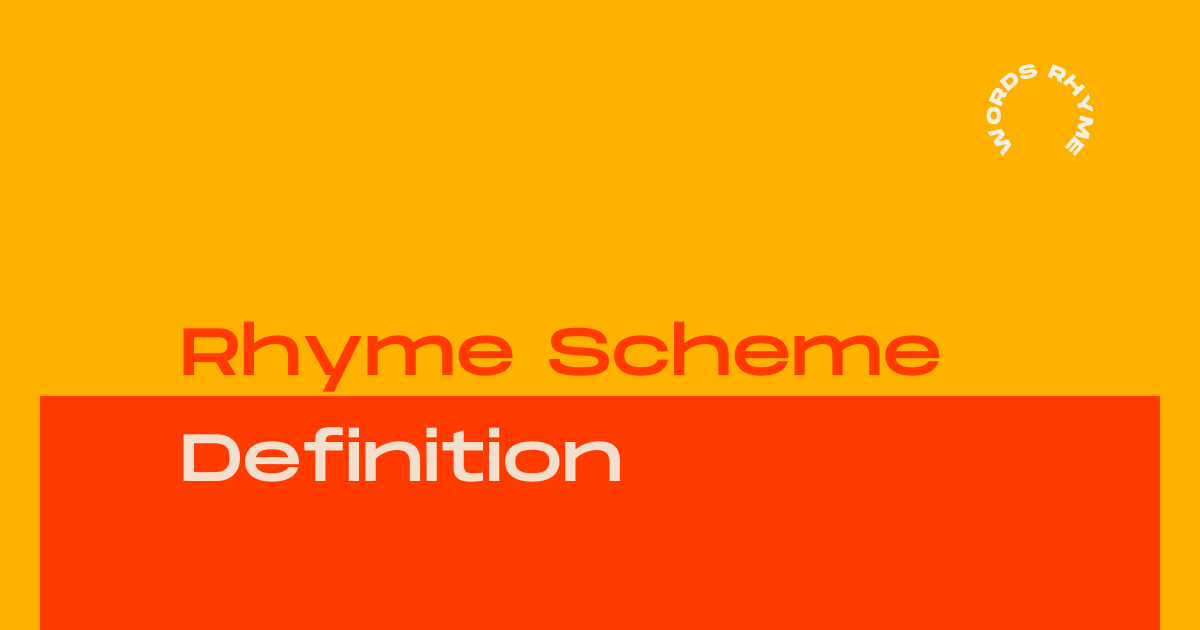Roses are red, violets are blue, poetry’s magic, awaits for you.
Have you ever wondered about the underlying structure that gives poetry its musicality? Rhyming is one of the key techniques poets employ to create melodic flow in their writing, but understanding the different rhyming patterns can seem mysterious without context.
In this blog post, we’ll demystify poetic form by exploring rhyme scheme definitions and different types of rhyming patterns. By the end, rhythm and rhyme will never seem quite so abstract again.
Table of Contents
Rhyme Scheme Definition

A rhyme scheme is the pattern of rhyming lines in a poem. It involves matching the sounds of words at the end of lines.
To define it simply, a rhyme scheme shows which lines in a poem rhyme with each other through a sequential pattern of letters. For example, ABAB means the first and third lines rhyme together, as do the second and fourth lines.
There are different types of rhyming patterns:
- * Perfect rhyme matches identical sounds at the end of lines, like “day/bay”.
- * Slant rhyme has similar but not identical ending sounds, like “tide/life”.
- * Near rhyme has a weaker resemblance in sound, such as “pink/link”.
As well as end rhymes, internal rhyme occurs within lines when words share consonant or vowel sounds anywhere in the text, not just at the ends of lines. This adds layers of musical texture throughout poems.
Popular Rhyme Schemes
Couplet (AABB) – Two lines that rhyme together followed by another pair of rhyming lines. Used in heroic couplets.
Alternating Rhyme (ABAB) – A rhyme scheme where two lines rhyme, followed by two lines that rhyme with each other but not the previous pair. Used in hymns and sonnets.
Enclosed Rhyme (ABBA) – The first and last lines of the stanza rhyme (enclosed rhyme) while the internal lines alternate rhyme. Used in ballads and songs.
Ballad Rhyme (ABAB CDCD EFEF) – A quatrain rhyme scheme where each stanza has couplets, with a repeated pattern for successive stanzas. Common in ballads and folk songs.
Spenserian Stanza (ABAB BCBC CDDC EE) – A nine-line stanza rhyming ABABBCBCC followed by a final rhyming couplet (though variants exist). Popularized by Edmund Spenser’s Faerie Queene, known for its flowing iambic pentameter.
Advanced Rhyme Schemes
Terza Rima (ABA BCB CDC DED) – A triolet scheme where the third line of each tercet rhymes with the first line of the next tercet. Creates an interwoven structure. Used in Dante’s Divine Comedy.
Villanelle (ABBAA2 abA1 abA2 abA1 abA2) – A nineteen-line poem with two rhymes used throughout in a strict pattern. Features repeated refrains. Known for its meditative qualities.
Triplet (AAA) – Three lines that rhyme together with no break. Provides an opportunity for expansion within a short form.
Sestina (ABCDEF FAEBDC CFBAED DCBAFE EDCABF) – A 39-line poem using six rhyming words rotated throughout interlocking sixains. Highly structured form requiring ingenuity within strict confines.
Together, understanding these rhyming techniques helps to analyze poetic form. The rhyme scheme gives clues as to how the poet manipulates sound on a structural level.

Why are Rhyming Patterns Important?
Intricate and sophisticated, rhyming patterns infuse poetry with the soulful and exquisite quintessential of the artist’s heart. They are important because:
They add musicality and flow. Rhyming lines create an auditory pattern that is pleasing to the ear. It gives the poetry a lyrical, almost song-like quality.
They help with memorability. Rhyming lines tend to stick in the mind better. The repetition of similar sounds at the end of the lines reinforces the words and makes the poem more memorable.
They convey meaning. The pattern of rhymes can emphasize certain ideas or words by giving them melodic prominence. Returning rhymes can hint at themes that recur throughout the poem.
They establish form and structure. Following a rhyme scheme holds the poem together compositionally. It gives the words framework and helps organize the content. Deviations from the pattern can also be used strategically.
They reflect the sound of language. Rhyming captures part of the music inherent in any language. It celebrates the auditory qualities of words beyond just their literal denotations.
They create rhythmic momentum. Rhyming drives the cadence and propels the language forward in a way that engages the reader/speaker. It generates energy and flow within the lines.
Fun Facts about Rhyme Schemes
- The word ‘rhyme’ comes from the Ancient Greek ῥυθμός (rhythmos or rhymth), so, rhyme and rhythm are intertwined even at their root!
- Rhyme emerged in the West during the medieval period, but it’s been used as far back as the 10th century BCE in China.
- Geoffrey Chaucer is famously known as the father of English poetry!
- Some words have no perfect rhymes in English, like “orange,” “marathon,” and “ninth.” Can you think of any others?
- Some poets are known for their unique use of rhyme schemes, making it almost a signature style. For example, Emily Dickinson often used slant rhymes in her works.


